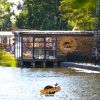Piața Amzei – Between old identity and modern reconfigurations

By Bucharest Team
- Articles
Just minutes away from the bustling Magheru Boulevard and Piața Romană, Piața Amzei holds a unique place in Bucharest’s urban fabric. Less flashy than the city’s major commercial hubs, Amzei is layered with a complex history—a crossroads where eclectic urbanism meets cultural initiatives and the ongoing tension between tradition and modernity. Today, Piața Amzei is less a traditional food market and more an urban laboratory seeking a fresh identity.
From Amzei Neighborhood to the City’s Beating Heart
The name comes from Amzei Church, built in the early 19th century by the boyar Amza Năescu. The neighborhood grew around the church, becoming a vibrant commercial and social hub. Its central location offered a strategic advantage within a city expanding both chaotically and organically.
Between the wars, Amzei emerged as a gathering place for the city’s petite bourgeoisie. Fresh vegetables and meat were sold in the market hall, alongside fabrics, perfumes, and imported goods in nearby shops. It was one of Bucharest’s elegant markets, frequented by residents of solid houses with French architectural influences, owned by prominent families.
A place in constant negotiation between past and future
Major changes started in the 2000s. The old market hall was demolished in 2010 despite local protests, replaced by a modern glass-and-metal structure inaugurated in 2015. Designed as a multifunctional space—a mix of market, art gallery, and event venue—it struggled to find a steady flow of tenants and visitors for years.
The issue wasn’t lack of space but a lack of a clear vision. Torn between becoming a contemporary cultural hub and preserving its traditional market role, Amzei wavered. Vegetable sellers were moved to temporary tents or adjacent spaces, and foot traffic declined. Locals expressed their confusion: “I’ve been coming to Amzei market all my life. Now, I don’t know what it is anymore. Market? Café? Museum?” said an elderly woman in a local report.
A new urban energy: cafés, bookstores, festivals
Yet, Piața Amzei was far from forgotten. In recent years, it has experienced a subtle but meaningful revival driven by creative initiatives. The Humanitas bookstore at the corner hosts launches, screenings, and debates. Specialty cafés like M60 have fostered a micro-community of creatives and freelancers.
Amzei has also hosted design fairs, temporary exhibitions, multimedia installations, and street food events. In summer, the outdoor space transforms into a venue for open-air screenings and acoustic concerts organized by the city hall or cultural NGOs. Far from being a trendy hotspot in a superficial sense, Amzei is carving out a role as an urban node with cultural significance—an aesthetic of contrast and rediscovery.
The neighborhood charm that refuses to surrender
The true magic of the area lies in its urban atmosphere. The small streets branching from the square—Cristian Tell, Mendeleev, Biserica Amzei—retain a neighborhood feel, despite being just five minutes on foot from Bucharest’s busiest boulevard. You can still sense the shadow of a bygone bourgeoisie alongside the pulse of a city reinventing itself in every space left untouched by large-scale developments.
Piața Amzei is neither a classic market nor a cultural mall. It may be one of the few places in Bucharest where the past, the uncertainty of the present, and hopes for a more welcoming urban future coexist without cancelling each other out.
Photo: Mihai Petre






























